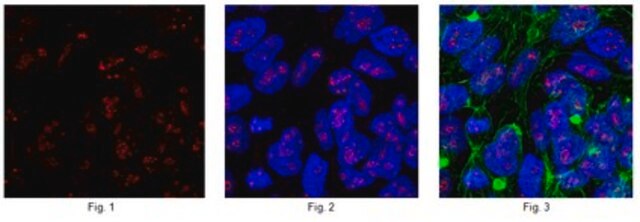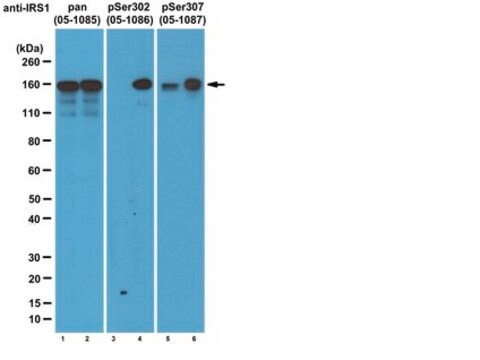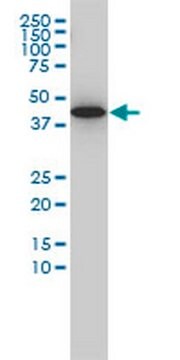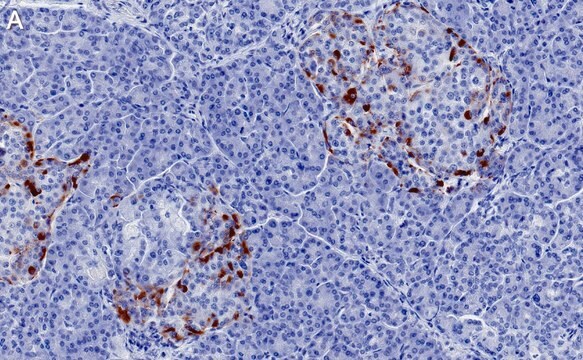ABN1727
Anti-CASZ1 Antibody
from guinea pig
Sinônimo(s):
Zinc finger protein castor homolog 1, Castor-related protein, CASZ1V1, CASZ1V2, Putative survival-related protein, Zinc finger protein 693
About This Item
Produtos recomendados
fonte biológica
guinea pig
Nível de qualidade
forma do anticorpo
unpurified
tipo de produto de anticorpo
primary antibodies
clone
polyclonal
reatividade de espécies
mouse, human
técnica(s)
immunocytochemistry: suitable
immunofluorescence: suitable
immunoprecipitation (IP): suitable
western blot: suitable
nº de adesão NCBI
nº de adesão UniProt
Condições de expedição
ambient
modificação pós-traducional do alvo
unmodified
Informações sobre genes
human ... CASZ1(54897)
mouse ... Casz1(69743)
Descrição geral
Especificidade
Imunogênio
Aplicação
Immunofluorescence Analysis: A 1:1,000 dilution from a representative lot detected CASZ1 immunoreactivity only among EYFP-negative cells, but not EYFP-positive Casz1-knockout cells by fluorescent immunohistochemistry staining of 4% paraformaldehyde-fixed retina cryosections from E17.5 transgenic mouse embryos carrying floxed Casz1 alleles and a ROSA26-floxed-stop::EYFP reporter allele, as well as Pax6 promoter-driven cre recombinase expression to allow tissue-specific (conditional) Casz1 knockout (Courtesy of Pierre Mattar, Christine Jolicoeur, and Michel Cayouette, Institut de recherches cliniques de Montreal (IRCM), Canada).
Immunoprecipitation Analysis: 5 µL from a representative lot immunoprecipitatd CASZ1 from 1 mg of mouse retina extract (Courtesy of Pierre Mattar, Christine Jolicoeur, and Michel Cayouette, Institut de recherches cliniques de Montreal (IRCM), Canada).
Western Blotting Analysis: A 1:1,000 dilution from a representative lot detected both CASZ1 spliced variants (CASZ1V1 and CASZ1V2) of either human or mouse origin in 20 µg of lysates from respective HEK293T transfectants (Courtesy of Pierre Mattar, Christine Jolicoeur, and Michel Cayouette, Institut de recherches cliniques de Montreal (IRCM), Canada).
Western Blotting Analysis: A 1:500 dilution from a representative lot detected a CASZ1 immunoreactive band in E17.5 mouse embryonic retina extract, but not in lysate from untransfected HEK293 cells (Courtesy of Pierre Mattar, Christine Jolicoeur, and Michel Cayouette, Institut de recherches cliniques de Montreal (IRCM), Canada).
Neuroscience
Qualidade
Western Blotting Analysis: A 1:5,000 dilution of this antiserum detected both CASZ1 spliced variants (CASZ1V1 and CASZ1V2) of either human or mouse origin in 10 µg of lysates from respective HEK293T transfectants.
Descrição-alvo
forma física
Armazenamento e estabilidade
Handling Recommendations: Upon receipt and prior to removing the cap, centrifuge the vial and gently mix the solution. Aliquot into microcentrifuge tubes and store at -20°C. Avoid repeated freeze/thaw cycles, which may damage IgG and affect product performance.
Outras notas
Exoneração de responsabilidade
Não está encontrando o produto certo?
Experimente o nosso Ferramenta de seleção de produtos.
Código de classe de armazenamento
12 - Non Combustible Liquids
Classe de risco de água (WGK)
WGK 1
Ponto de fulgor (°F)
Not applicable
Ponto de fulgor (°C)
Not applicable
Certificados de análise (COA)
Busque Certificados de análise (COA) digitando o Número do Lote do produto. Os números de lote e remessa podem ser encontrados no rótulo de um produto após a palavra “Lot” ou “Batch”.
Já possui este produto?
Encontre a documentação dos produtos que você adquiriu recentemente na biblioteca de documentos.
Nossa equipe de cientistas tem experiência em todas as áreas de pesquisa, incluindo Life Sciences, ciência de materiais, síntese química, cromatografia, química analítica e muitas outras.
Entre em contato com a assistência técnica








